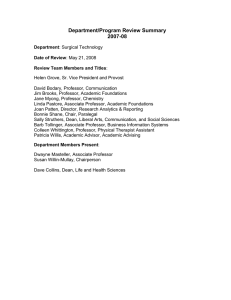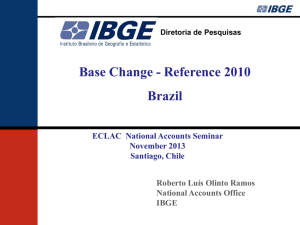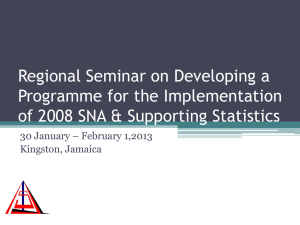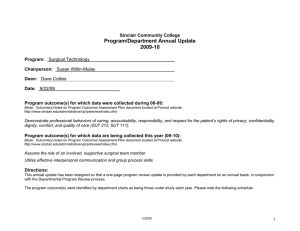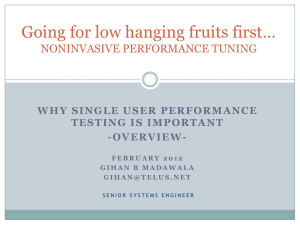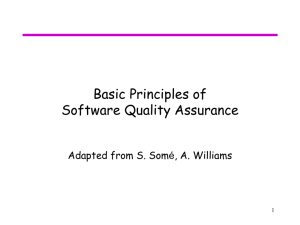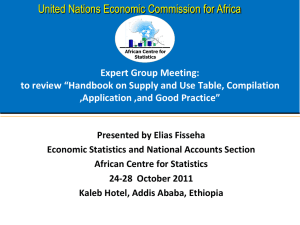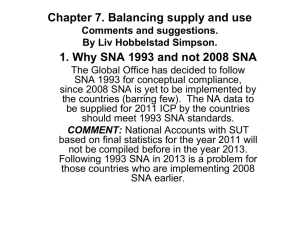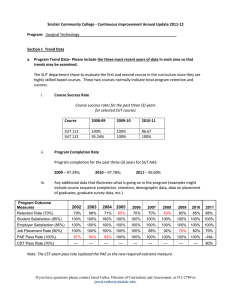Testing
advertisement
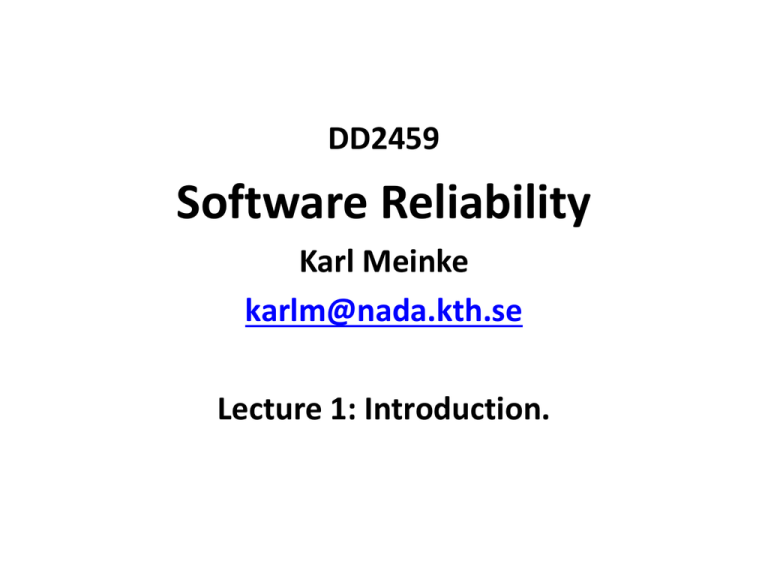
DD2459 Software Reliability Karl Meinke karlm@nada.kth.se Lecture 1: Introduction. Course Material • • • • This course is mainly about software testing We cover the whole testing activity We emphasize test design as a practical skill We consider classical and modern approaches to testing • We don’t have time to cover everything! • We might consider reliability models. Course Format • 7 lectures – fundamental theory + math • 7 exercise classes: alternate weeks – 1 week practical instructions – 1 week practical lab work • Labs are mini projects (3 points) – Work in pairs – Build or use existing tools • Short take-home exam (4.5 points) Course Material Amman and Offut, Introduction to Software Testing, Cambridge University Press, 2008. Jorgensen, Software Testing: a Craftsman’s Approach, Auerbach Publications, 2008. What is Testing? Black-box testing Load Testing Regression testing Random testing Functional testing Pairwise testing Random testing Unit testing Alpha/Beta testing Integration testing Acceptance testing System testing Performance testing Usability testing Some Definitions? • “Testing can show the presence of bugs but not their absence” (Dijkstra). • Testing concerns the design, execution and subsequent analysis of individual test cases to evaluate a system. • Testing concerns dynamic code execution (in situ) rather than static analysis • Testing has different goals according to one’s level of test maturity. IEEE SWEBOK 2004 • Testing is an activity performed for evaluating product quality, and for improving it, by identifying defects and problems … • Software testing consists of the dynamic verification of the behavior of a program on a finite set of test cases, suitably selected from the usually infinite executions domain, against the expected behavior. • www.swebok.org How to study? • Bewildering variety of themes • Try to find similarities of approach • Reusable concepts and techniques – E.g. graph models and coverage models • Focus on functional (behavioural) testing • Focus on test design • Use lab work to focus our studies The Price of Failure • NIST report (2002) – inadequate testing costs USA alone $22 - $59 billion dollars annually • Improved testing could half this cost • Web application failures – Financial services $6.5 million per hour – Credit card sales applications $2.4 million per hour • Symantec: most security vulnerabilities due to software errors. • NASA Mars lander (1999) due to an integration error • Ariane 5 explosion – exception handling bug, due to outdated requirement. $370 million • Toyota brakes: dozens dead, thousands of crashes • Therac-25 radiation machine: three dead • Major failures: Mars polar lander, Intel’s pentium bug • Airbus 319 – fly-by-wire concept Loss of autopilot, flight deck lighting, primary flight and navigation displays! • USA Northeast Blackout 2003 Financial losses of $6 Billion USD Alarm system in the energy management system failed due to a software error Operators were not informed of the power overload in the system Conclusions • Software is a skin that surrounds our civilisation (Amman and Offut) • We need software to be reliable • Testing is main method to assess reliability • Testing is becoming more important • Resources (manpower) for testing increases linearly • Complexity of software increases exponentially • Automated testing is inevitable (Traditional) Test Activities – 4 Types • Test design – Criteria based – Human based • • • • Test automation Test execution Test evaluation Need different skills, background knowledge, education and training. 1.a. Test Design – Criteria based • Design test values to satisfy coverage criteria or other engineering goal • Testing is a search problem, coverage measures search effort • Most technical and demanding job of all • Needs skills in – Discrete math – Programming – Testing • Traditional Computer Science Degree 1.b. Test Design – Human based • Design test values based on domain knowledge of program and human knowledge of testing • Criteria based approaches can be blind to situations • Requires knowledge of domain, testing and user interfaces • No traditional CS required Human-based (cont) • Background in the software domain is essential • Empirical background is helpful (biology, psychology etc) • A logic background is helpful (law, philosophy, math) • Work is experimental and intellectually stimulating. 2. Test Automation • Embed test values into executable scripts • Straightforward programming – Small pieces, simple algorithms – Junit, JBehaviour • Needs little theory • Little boring • Who determines and embeds the expected outputs? • What if system is non-deterministic? 3. Test Execution • • • • Run tests on the SUT and record results Easy and trivial if tests automated Very junior personnel Test executors must be careful and meticulous with book-keeping (e.g. time of day error?) • A test is an experiment in the real world. 4. Test Evaluation • Evaluate outcome of testing and report to developers • Test report • Psychological problems – blame etc • Test goals must be clear to assist debugging Other Activities • Test management: policy, group structure, integration with development, budget, scheduling. • Test maintenance: test reuse, repositories, historical data, statistics, regression testing. • Test documentation: – Document “why” criteria – Ensure traceability to requirements or architectural models. – Evolve with the product. Test cases User Requirements Acceptance testing Test cases Software Requirements Test cases Architecture Design System testing Integration testing Test cases Detailed design & Coding Unit Testing The ”V” model of Testing Integrates testing with waterfall lifecycle Time 22 Test Maturity Model (TMM) • Level 0: no difference between testing and debugging • Level 1: purpose is to show software works • Level 2: purpose is to show software fails • Level 3: purpose is to reduce risk of use • Level 4: purpose is a mental discipline for quality. Formal Definitions 1. Software Fault: a static defect in software 2. Software Error: an incorrect internal state manifesting a fault 3. Software Failure: External incorrect behaviour wrt requirements. Patient has a symptom of thirst (3), doctor finds high blood glucose (2), doctor diagnoses diabetes (1) • Test Failure: execution resulting in failure • Debugging: process of locating fault from failure • Test case values: input values needed to complete execution of the SUT • Expected results: results that should be produced iff SUT meets its requirements • Prefix (setup) values: input necessary to bring SUT to an appropriate state to receive test case values • Postfix (teardown) values: input needed to be sent after the test case values – Verification values: needed to recover the results – Exit values: needed to terminate or return to a stable state. Defn: Test Case • Test Case: the test case values, setup values, teardown values and expected values needed for one observation of the SUT. • Test Suite: a set of test cases. Coverage • Test requirement: A specific (structural) element r of an SUT that a test case must cover. • Examples: paths, branches, variable values. • Coverage Criterion: a set of rules that impose test requirements on a test suite. • Coverage: Given a set R of test requirements coming from a criterion C, a test suite T satisfies C iff for each r R there exists at least one t T which satisfies r. Varieties of System Under Test • Procedural (C code, FORTRAN, etc) – Precondition and postcondition • Reactive (ATM machine, fly-by-wire) – “always on” - event driven behaviour • • • • • • Real-time (soft/hard) Communications protocol Numerical (approximately correct) Object-oriented (class and method invariants) Distributed system (non-deterministic) GUI, user event generation must be simulated
